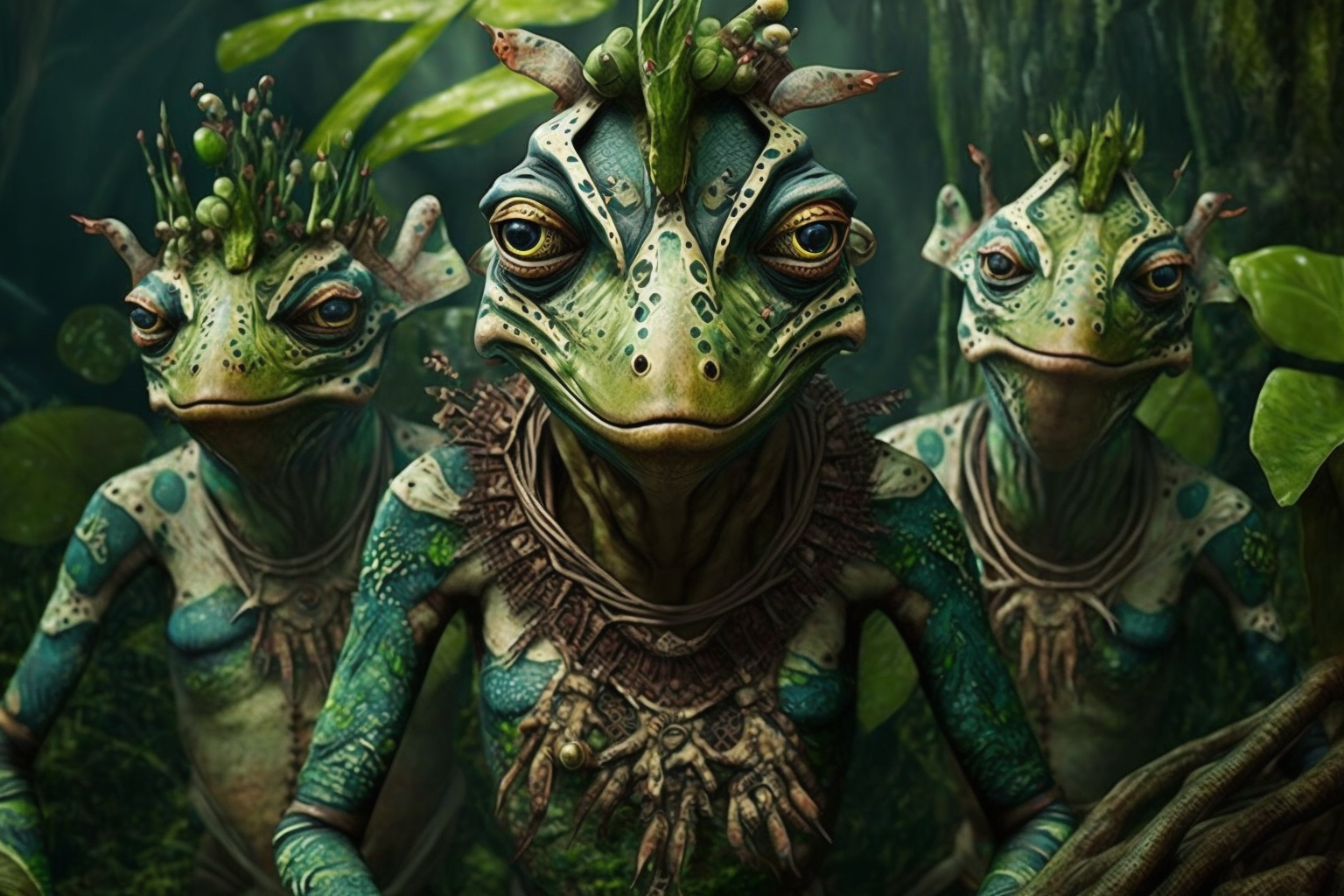Time to add some creatures to the world. Otokos fit especially well to the swampy jungles and mangroves near Zipopan and they live in smaller numbers in other areas of Kaliland also.

Otokos also known as frog-people
Otokos are a species of small, amphibious creatures that inhabit primitive communities in the swamps and jungles of Kaliland and the Orenic regions. While little is known about their history, humans have historically shown little love for otokos, and they have been eradicated wherever human civilization has spread. As a result, these creatures can only be found in the most untouched swamps and jungles.
Distribution and relationship with humans
Otokos are typically wary of humans and will begin tracking them if they enter the area that an otoko community considers their home and hunting grounds. If a person gets too close to an otoko village, the community may ruthlessly attack them in an attempt to kill or drive them away.
Otokos live in communities of 40 to 160 (4d4x10) members, with the community being ruled by a matriarch. Male and female otokos build the village, hunt, fish, and guard their hunting grounds.
While otokos generally avoid humans, there have been instances where new otoko communities have formed near human settlements on the edge of the jungle. In such cases, the community may harass the settlement by attacking individual people, stealing and killing their livestock, and so on. There have also been cases where otokos have attacked entire villages with large numbers of people.
Characters with a +4 Instinct who are beastmasters can learn the otoko language and command them.


Anatomy
Otokos are small amphibians that stand upright and can grow up to 150 cm tall. Adult otokos typically weigh about 40 to 50 kg. With their frog-like bodies and powerful hind legs, they are skilled jumpers. Like frogs, otokos have only four fingers and toes, with one finger developed like a thumb, which allows them to use tools and weapons. Otokos have a relatively short lifespan, reaching sexual maturity at 6 to 8 years old and living to be about 20 to 30 years old.
The birth and development of otoko is unusual. Every year, otokos have a mating season. A few weeks after the mating season, all fertilized female otokos leave their areas and search for a distant body of water to lay their eggs. When they are done, the female otokos return home. From the eggs that are not eaten by predators, tadpoles are born that live and feed in the selected body of water. The first otoko to come out of the water becomes the matriarch of the new group, usually about 2 to 3 years after birth. The young matriarch starts creating a living space for her community out of nothing while protecting the selected body of water so that her community members can come out one by one.

Otokos are born with the knowledge of how to make throwing weapons, harpoons for fishing, traps for hunting, and so on. They also know which plants are poisonous and which are not, and they are able to use poisons to their advantage. The collective subconscious of otokos is highly developed, and usually, a new generation of the tribe remains in the same place where they were born.
If the mother of the tribe has chosen the spawning ground wisely, there will be no conflicts between the new and previous generations. However, the unique way in which otokos are born means that no otoko tribe lives longer than its oldest member, resulting in no progress in otoko knowledge and skills. Sometimes, a new otoko tribe takes over a village of a previously extinct tribe.
Diet and natural enemies
Otokos are skilled at survival in their jungle environment, relying on hunting, fishing, and gathering to sustain themselves. Being omnivores, they can hunt practically any animal thanks to their speed and use of poison, with some even claiming they are capable of hunting elephants and large predators.
However, otoko also face threats from natural enemies, including simple fish that can consume an entire tribe before it grows large enough to leave the water and large predators like jaguars, giant gorillas, crocodiles, and anacondas. Despite these dangers, the greatest enemy of adult otoko is humans.
Tactics
Otoko ambushes can be very dangerous. They ambush game or people passing through their hunting grounds in groups of up to 10, and their method of attack is to weaken the opponent with poison, then quickly retreat and set up a new ambush against the confused or fleeing victim. They repeat this tactic until they believe the opponent is weak enough for a direct attack. Then they pounce on the weakened opponent with the whole hunting party.
By water, they can ambush from below because they are skilled swimmers and amphibious.




























Leave a Reply